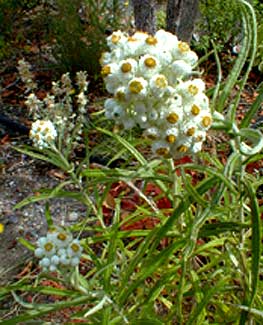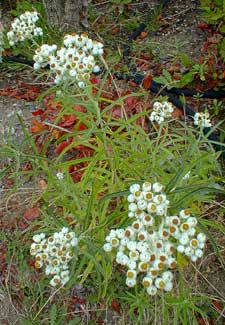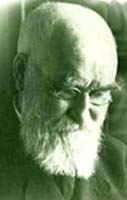
Macoun's Cudweed,
Clammy or Sticky Rabbit's Tobacco,
Western Everlasting or Lasting,
False Cotton-batting Plant
or Cottonweed, or Western Catfoot
"None can have a healthy love for flowers
unless he loves the wild ones."
-Forbes Watson
(1880-1960)
(1880-1960)
Pseudonaphalium macouni is the priority name of a native wildflower also known as P. viscosum, Gnaphalium viscosum, G. macouni, & G. decurrens. It's native of right here in my neighborhood, the Kitsap & Olympic Penninsulas, as well as most of Canada & the northern United States, & through the middle of the United States to the Gulf Coast, but not in California where it is displaced by a couple near-identical species, nor in the far southern states.
It appeared in our roadside sun-garden in 2002 uninvited, but I did not molest it, & it returned in 2003 as a much larger clump, though still under two feet tall. It is usually an annual, but often enough biennial. Unless it successfully self-seeds in its place, which it could easily do, it might vanish after a couple of years.
My great-gram Elvie encouraged this weed, along with yarrows, to grow all around a stump at the edge of a meadow. Her many grandkids would pick them & at one time or another she taught all of us the fine & simple art of drying flowers, as these are among the easiest to dry for long-lasting flower arrangments.
 It was an old farm practice to plant just such zero-mainteance medicinal herbs like yarrows & cudweeds at poperty edges, to harvest for use in home remedies. Cudweeds provided tonic teas & were used to make mild astringents for baths or gargle. They were long believed to relieve mild pain, tummy aches & cramps, & to treat the common cold or even pneumonia, as well as having a sedative value.
It was an old farm practice to plant just such zero-mainteance medicinal herbs like yarrows & cudweeds at poperty edges, to harvest for use in home remedies. Cudweeds provided tonic teas & were used to make mild astringents for baths or gargle. They were long believed to relieve mild pain, tummy aches & cramps, & to treat the common cold or even pneumonia, as well as having a sedative value.Several Gnaphalium & Pseudognaphalium species have undergone scientific biological screenings attempting to find a basis beyond placebo effect for any actual medicinal component. Resinous exudates have been shown indeed to have antimicrobial or fungicidal properties. So among its many alleged values, it might well be effective when used as an astringent gargle. Other claims for it remain suspect or are at best minimally effective, but neither are its minor flavonoids & diterpenoids apt to prove harmful.
The common names Cudweed & western Rabbit-tobacco alludes to it being a favorite food item of rabbits, whose cud-chewing is supposed to reflect Cudweed's role as a tobacco or chaw substitute. P. macouni in the west like the east coast's similar Gnaphalium obtusifolium, as well as other less common look-alikes in each genus, were used by First Peoples as tobacco substitutes, with additional species in South America likewise chewed or smoked by indigenous peoples. Asian species similarly entered into the Chinese herbal pharmacy.
An 1891 ethnographic study by James Moody reported that predominantly P. macouni (which he knew as G. decurrens) but also two other species of cudweeds were used in Cherokee sacred formulas in decoctions to treat colds & lung infections. Cherokee, Chippawa, Potawatomi & Cheyenne peoples were among the many who would put cudweeds on coals in their sweat lodges assuming health benefits of breathing the smoke, which was believed to invite good spirits while scattering away evil spirits. Cheyenne furthermore obtained a dye from cudweed to rub upon their bodies as protection in battle.
 Numerous species of Pseudognapholium many of which look sufficiently like Gnapholiums that taxononomists have moved various ones back & forth between the two genera. I'm not 100% certain I've identified this one correctly; but the two most common look-alikes are P. macounii & G. obtusifolium. Where their extensive ranges overlap (in much of North America, though G. obtusifolium does not extend into the west), it should be easy to tell them apart. The Eastern cudweed has slightly elongated flowers in a looser raceme; the Western's similarly miniscule chrysantheum-like blooms make up a more compact raceme & are flat-topped & barrel shaped, showing off the yellow "eye" more overtly. The long slender leaves are also different, slightly tapering at the base for the Eastern, but not for the Western.
Numerous species of Pseudognapholium many of which look sufficiently like Gnapholiums that taxononomists have moved various ones back & forth between the two genera. I'm not 100% certain I've identified this one correctly; but the two most common look-alikes are P. macounii & G. obtusifolium. Where their extensive ranges overlap (in much of North America, though G. obtusifolium does not extend into the west), it should be easy to tell them apart. The Eastern cudweed has slightly elongated flowers in a looser raceme; the Western's similarly miniscule chrysantheum-like blooms make up a more compact raceme & are flat-topped & barrel shaped, showing off the yellow "eye" more overtly. The long slender leaves are also different, slightly tapering at the base for the Eastern, but not for the Western.Macoun's Cudweed blooms from July to November, hence the other common name Everlasting. It is named after John Macoun (1831-1920), one of the great Canadian naturalists of the Nineteenth Century, whose portrait is shown on the left.
Western or Macoun's Everlasting is not ordinarily grown as a garden ornamental, though it is wild-gathered to dry in flower arrangements or as a medicinal herb. In our vicinity it is not such a common weed that it causes any worry as a garden-invader, & in some areas of its extensive natural range it has become rare. I find it pretty enough to view it as a welcome volunteer.
The "everlasting" nature of the flowers does strike me as an ornamental plus making it a worthily gardenable wildflower. Others more inclined to make tonic teas from their home-grown herbs will find it of even greater value.